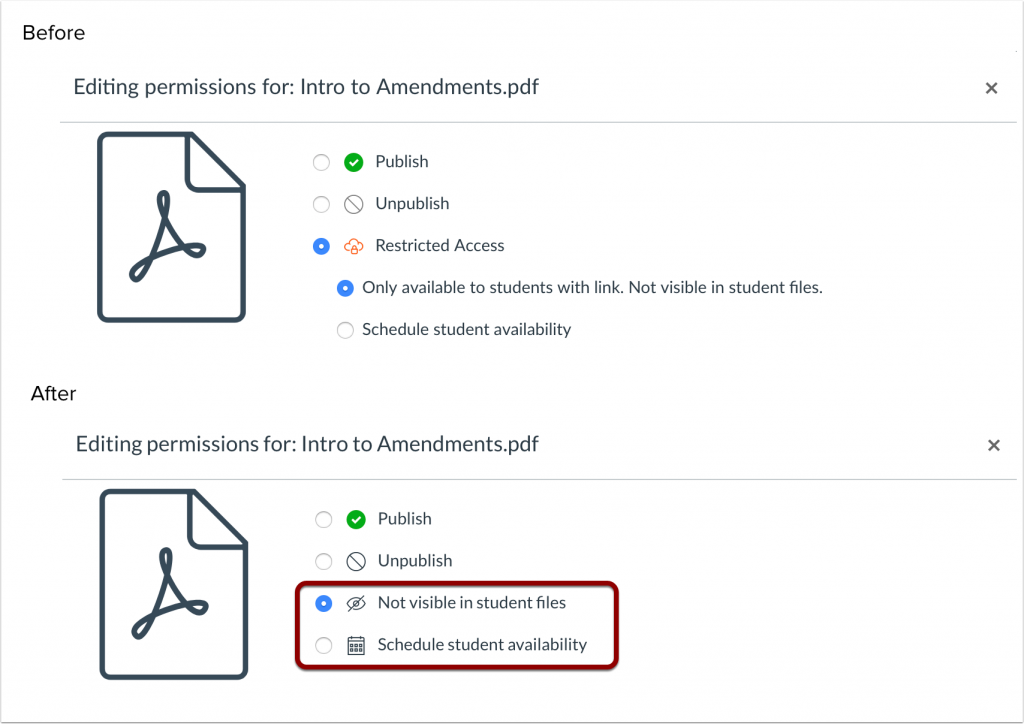Canvas operates on a three-week release cycle through which features are added or updated; feature releases in the production environment take place on the third Saturday of every month, beginning August 17. SUNY Geneseo’s EdTech team posts highlights from Canvas’s production release notes, a link to these notes, and other relevant content to our blog a few days before the production release, which usually occurs on Saturdays. Please contact the Canvas Support Team if you have any questions about the following changes made to the Canvas environment between May 2019 through August 2019. Click here to go directly to our notes on New Gradebook.
Commons LTI
- Replaced Flickr with Unsplash to search for and select images as resource thumbnails
- Existing images imported from Flickr will not be affected
- Search page now includes featured content at the top
- Easily identifiable, high quality instructional content curated by the Commons team and highlighted to benefit all Commons users
- Viewable to all Commons users and cannot be minimized on the page
- Imported tab now includes a search field for users to search for, sort, and filter by previously imported resources
Conversations
- To improve accessibility in the Compose Message window, previously received messages in the thread display below the text field; the Remove option to each specific message has been removed.
- Individual messages can still be deleted from a conversation in the Conversations window by opening the message, selecting the Settings menu, and clicking the Delete link.
Course Import Tool
- Instructors with a trust account enrollment (as a “teacher”) can copy those courses, and/or select content, into the Geneseo instance using the Course Import Tool
- This option is currently limited to accounts located in the same region.
- Courses available for course copy are based strictly on enrollment; courses do not provide any indication that they are associated with a trust account.
Course Settings
- Replaced Flickr with Unsplash to search for and select images as course card images
- Existing images imported from Flickr will not be affected
Discussions
- When students are not allowed to edit/delete their own posts, the Settings menu for a discussion shows these functions as disabled
- Previously, when these settings were disabled, the Settings menu was removed
- The option to allow students to attach files to discussions is enabled by default
- Instructors can disable this option in Course Settings or the Discussions Settings menu
Files: Restricted Access Permissions Interface
- Permissions surrounding access to restricted files have been clarified through two separate options, with unique icons for each type, as shown below to the left
- The icon for the specified option is reflected in the Files list, as shown below to the right
- This change more clearly defines the two options offered for files set with restricted access; no changes were made to functionality

Restricted file access comparison. 
Restricted file access icon update.
New Gradebook
- The “Message Students Who” window displays names in alphabetical order
- Names remain alphabetized when different messaging criterion is selected.
- A new filter, Student Groups, was added to the View menu as a filter option
- Groups will display hierarchically
- Student Names column has the option to display group names as secondary information
- Using the three vertical dots (e.g., options menu) in the column header, select secondary info, and change from the default of section to group
Grade Post Policies
- Instructors can control when grades are released to learners (manually or automatically)
- Grade posting policy can be set, course-wide, in gradebook settings
- Sets for all current and future assignments
- Default is automatically post grades (assignment grades visible to students as soon as they are entered
- Manually posting grades is synonymous with muting an assignment
- Allows instructors to, essentially, mute all graded activities at the start of a course and post grades, when ready, by adjusting the policy at the assignment level
- After setting the policy, individual assignments can be changed using the 3 vertical dots in the assignment menu (from the gradebook)
- Muting grade icon replaced with an eye to reflect the assignment’s grade visibility
- Transparent eye displays for assignments with a manually posted grade policy
- Manually posting grades will hide grades, by default.
- Any grades that have already posted will remain visible
- The instructor must choose when to post grades, for each assignment, on corresponding column in the gradebook
- When selecting the option to manually post grades, at the course or assignment-level, the instructor sees clarification on what it means for the students
- When an instructor enters a grade for a manually posted assignment, the icon changes to a solid orangey-red to show its grades are not visible to students. When opened, the grade detail tray confirms with a “hidden” label for all hidden submissions. A dot, of the same color, also appears next to individual graded, and hidden, submissions
- Instructor can post grades to students at any time (from the assignment menu’s three vertical dots > “Post Grades”)
- The post grades sidebar identifies # of submissions that are hidden and the # of submissions graded but not posted
- Can post grades to everyone or post only for students with graded submissions
- Both options support instructor’s posting to one or multiple specific sections in a course
- Grades can be hidden or re-hidden at any time!
- This is the equivalent of muting/unmuting an assignment
- Assignment menu’s “Hide Grades” option displays for assignments where grades are visible to students
- Can hide to all students (by default) or select one or multiple sections where grades should be hidden
- When grades are hidden, the transparent eye changes to a colored, solid state
- Grades can be hidden/posted in SpeedGrader
- Hidden label displays in sidebar when a grade is entered for manually post assignments
- The Eye icon (top left-hand side of the screen, second icon from the left) manages the grade policy the same way as the assignment menu does in the Gradebook
- Student View: when grades are manually posted and hidden to students, learners see the Eye icon in the Grades page. When posted, students see the grade and any comments in the Grades page.
- Anonymous assignments must be manually posted regardless of the course-level grade policy — protects student anonymity
- Cannot be managed by section so post or hide for all students in the assignment
- Before posting grades, instructor sees clarification in the Post Grades sidebar that the browser will reload to remove anonymity from all submissions and grades become visible in the Gradebook and the student Grades page
- Moderated assignments: To be included in the Gradebook, moderated assignments must follow the regular moderation workflow.
- After the moderator has selected grades for all students and posted grades, the grades display in the New Gradebook
- If the moderator wants to keep grades hidden, the Display to Students option should not be selected, and grades can be posted to students in the Gradebook at a later date
- However, if grades are displayed to students and an instructor wants to keep them hidden, grades can be re-hidden in the Gradebook using the Hide Grades option
(Select) Bug Fixes
- External Tool (LTI) Submissions
- When four or more external tools are enabled for a course, External Tool assignments can be submitted using the More tab
- Blueprint courses
- File paths created in pages by linking files from the Rich Content Editor are retained in course copies
- Dashboard “To Do” Grading Counts
- Grading count notifications are only visible to users whose section(s) require submission grading
- DocViewer: Stylus Use
- In DocViewer, the stylus action button is not required for point, free draw, free text, or area annotation types
- DocViewer: File Preview
- DocViewer previews of XLSX files render empty rows and columns to maintain formatting from the original document
- Graphs created in spreadsheets and rendered in DocViewer display correct data and legend information
- Scatter graphs in Word documents correctly display trendlines in DocViewer
- Link validator
- Canvas code has been updated to not identify local redirect links as broken
- New Gradebook
- Text entries downloaded from anonymously graded assignments no longer include the student’s name
- Canvas code has been updated to immediately display the Days text field, within the Grade Detail Tray, when a Late status is applied
- Notifications
- Content published within locked modules are not included in Updated Page notifications
- Rubrics
- Rubrics that include saved comments through the Free-form Comments option display all comments in the sidebar
- SpeedGrader
- Student profile pictures are updated to correctly display, in the SpeedGrader menu, the student whose submission is being viewed in SpeedGrader
You can find the full documentation, available from Instructure, informing our Summer 2019 Release Notes Recap within the Canvas Community.
- 5/11/19 Canvas Release Notes
- 6/1/19 Canvas Release Notes
- 6/22/19 Canvas Release Notes
- 7/13/19 Canvas Release Notes
- 8/17/19 Canvas Release Notes
You do not need to log in to access this content. Please contact Geneseo’s Canvas Support Team with your questions. Reach us by email (canvas@geneseo.edu) or through the Canvas Hotline at 585.245.6000 (weekdays 8AM – 4PM). Happy learning!
